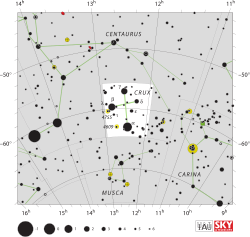Kappa Crucis
| Kappa Crucis (κ) | |
 | |
| Observationsdata Epok: J2000.0 | |
|---|---|
| Stjärnbild | Södra korset |
| Rektascension | 12t 53m 48,91920s[1] |
| Deklination | -60° 22′ 34,4808″[1] |
| Skenbar magnitud () | +5,98[2] |
| Stjärntyp | |
| Spektraltyp | B3 Ia[3] |
| U–B | -0,58[2] |
| B–V | +0,22[2] |
| Astrometri | |
| Radialhastighet () | -3,5[4] km/s |
| Egenrörelse (µ) | RA: -3,60[1] mas/år Dek.: -1,89[1] mas/år |
| Parallax () | 27,17 ± 0,24[1] |
| Avstånd | ca 2 600[5][6] lå |
| Absolut magnitud () | -7,1[7] |
| Detaljer | |
| Massa | 23,0[8] M☉ |
| Luminositet | 151 000[8] L☉ |
| Temperatur | 16 300[8] K |
| Vinkelhastighet | 70[8] km/s |
| Ålder | 11,2[5] miljoner år |
| Andra beteckningar | |
| κ Cru, CD-59° 4460, HD 111973, HIP 62931, HR 4890, SAO 252077, 2MASS J12534890-6022344 | |
Kappa Crucis (κ Crucis, förkortat Kappa Cru, κ Cru) som är stjärnans Bayerbeteckning, är en spektroskopisk dubbelstjärna belägen i den östra delen av stjärnbilden Södra korset. Den har en skenbar magnitud på 5,98[2] och är svagt synlig för blotta ögat där ljusföroreningar ej förekommer. Baserat på parallaxmätning inom Hipparcosuppdraget på ca -1,32[1] mas, beräknas den befinna sig på ett avstånd på ca 2 600 ljusår (ca 37 parsek) från solen. Stjärnan ingår i den öppna stjärnhopen NGC 4755, även kallad Kappa Crucis-hopen eller Juvelskrinet[9].
Egenskaper
Kappa Crucis är en blå till vit superjättestjärna av spektralklass B3 Ia[3]. Radiella hastighetsvariationer i spektrallinjerna tyder på att den har en oupplöst följeslagare.[10] Den har massa som är ca 23[8] gånger större än solens massa och utsänder från dess fotosfär ca 151 000[8] gånger mera energi än solen vid en effektiv temperatur av ca 16 300[8] K.
Referenser
- Den här artikeln är helt eller delvis baserad på material från engelskspråkiga Wikipedia, tidigare version.
Noter
- ^ [a b c d e f] van Leeuwen, F. (2007), "Validation of the new Hipparcos reduction", Astronomy and Astrophysics, 474 (2): 653–664, arXiv:0708.1752 , Bibcode:2007A&A...474..653V, doi:10.1051/0004-6361:20078357.
- ^ [a b c d] Dachs, J.; Kaiser, D. (November 1984), "UBV photometry of the southern galactic cluster NGC 4755 = Kappa Crucis", Astronomy and Astrophysics Supplement Series, 58: 411–429, Bibcode:1984A&AS...58..411D.
- ^ [a b] Prinja, R. K.; Massa, D. L. (October 2010), "Signature of wide-spread clumping in B supergiant winds", Astronomy and Astrophysics, 521: 4, arXiv:1007.2744 , Bibcode:2010A&A...521L..55P, doi:10.1051/0004-6361/201015252, L55.
- ^ Gontcharov, G. A. (November 2006), "Pulkovo Compilation of Radial Velocities for 35 495 Hipparcos stars in a common system", Astronomy Letters, 32 (11): 759–771, arXiv:1606.08053 , Bibcode:2006AstL...32..759G, doi:10.1134/S1063773706110065.
- ^ [a b] Aidelman, Y.; Cidale, L. S.; Zorec, J.; Arias, M. L. (2012). "Open clusters. I. Fundamental parameters of B stars in NGC 3766 and NGC 4755". Astronomy & Astrophysics. 544: A64. Bibcode:2012A&A...544A..64A. doi:10.1051/0004-6361/201219069.
- ^ Corti, M. A.; Orellana, R. B. (2013). "Members of Centaurus OB1 and NGC 4755: New spectroscopic and astrometric studies". Astronomy & Astrophysics. 553: A108. Bibcode:2013A&A...553A.108C. doi:10.1051/0004-6361/201220743.
- ^ Humphreys, R. M. (1978). "Studies of luminous stars in nearby galaxies. I. Supergiants and O stars in the Milky Way". Astrophysical Journal. 38: 309. Bibcode:1978ApJS...38..309H. doi:10.1086/190559.
- ^ [a b c d e f g] Dufton, P. L.; et al. (2006), "The VLT-FLAMES survey of massive stars: Stellar parameters and rotational velocities in NGC 3293, NGC 4755 and NGC 6611", Astronomy and Astrophysics, 457: 265–280, arXiv:astro-ph/0606409 , Bibcode:2006A&A...457..265D, doi:10.1051/0004-6361:20065392.
- ^ Kharchenko, N. V.; Piskunov, A. E.; Röser, S.; Schilbach, E.; Scholz, R.-D. (2004). "Astrophysical supplements to the ASCC-2.5. II. Membership probabilities in 520 Galactic open cluster sky areas". Astronomische Nachrichten. 325 (9): 740–748. Bibcode:2004AN....325..740K. doi:10.1002/asna.200410256.
- ^ Chini, R.; Hoffmeister, V. H.; Nasseri, A.; Stahl, O.; Zinnecker, H. (2012). "A spectroscopic survey on the multiplicity of high-mass stars". Monthly Notices of the Royal Astronomical Society. 424 (3): 1925–1929. arXiv:1205.5238 . Bibcode:2012MNRAS.424.1925C. doi:10.1111/j.1365-2966.2012.21317.x.
Externa länkar
| |||||||||||||||||||
Media som används på denna webbplats
This image is a “close-up” view from the NASA/ESA Hubble Space Telescope of NGC 4755, or the Jewel Box cluster. Several very bright, pale blue super-giant stars (eg. κ Crucis on the left, HD 111934 on the lower right and HIP 62913 in the middle right), a solitary ruby-red super-giant (HIP 62918 - upper right) and a variety of other brilliantly coloured stars are visible in the image, as well as many much fainter ones, often with intriguing colours. The huge variety in brightness exists because the brighter stars are 15 to 20 times the mass of the Sun, while the dim points are less than half the mass of the Sun. This is the first image of an open galactic cluster with imaging extending from the far ultraviolet to the near-infra-red.
Författare/Upphovsman: IAU and Sky & Telescope magazine (Roger Sinnott & Rick Fienberg), Licens: CC BY 3.0
IAU Crux chart




